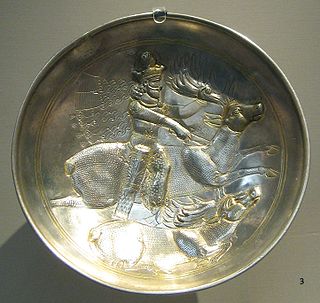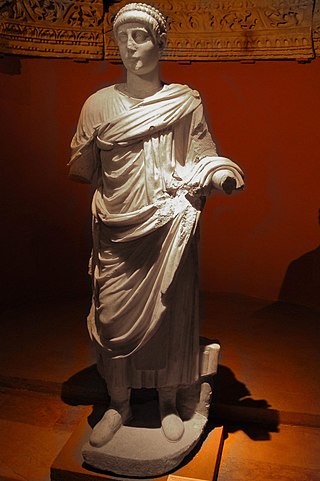The 400s decade ran from January 1, 400, to December 31, 409.
The 380s decade ran from January 1, 380, to December 31, 389.
The 420s decade ran from January 1, 420, to December 31, 429.
The 450s decade ran from January 1, 450, to December 31, 459.
Year 392 (CCCXCII) was a leap year starting on Thursday of the Julian calendar. At the time, it was known as the Year of the Consulship of Augustus and Rufinus. The denomination 392 for this year has been used since the early medieval period, when the Anno Domini calendar era became the prevalent method in Europe for naming years.
The 390s decade ran from January 1, 390 to December 31, 399

Year 455 (CDLV) was a common year starting on Saturday of the Julian calendar. At the time, it was known as the Year of the Consulship of Valentinianus and Anthemius. The denomination 455 for this year has been used since the early medieval period, when the Anno Domini calendar era became the prevalent method in Europe for naming years.
The 360s decade ran from January 1, 360, to December 31, 369.
The 340s decade ran from January 1, 340, to December 31, 349.
The 370s decade ran from January 1, 370, to December 31, 379.
The 280's decade ran from January 1, 280, to December 31, 289.
Year 380 (CCCLXXX) was a leap year starting on Wednesday of the Julian calendar. At the time, it was known as the Year of the Consulship of Augustus and Augustus. The denomination 380 for this year has been used since the early medieval period, when the Anno Domini calendar era became the prevalent method in Europe for naming years.

Year 304 (CCCIV) was a leap year starting on Saturday of the Julian calendar. It was known in the Roman Empire as the Year of the Consulship of Diocletian and Maximian. The denomination 304 for this year has been used since the early medieval period, when the Anno Domini calendar era became the prevalent method in Europe for naming years.

Year 371 (CCCLXXI) was a common year starting on Saturday of the Julian calendar. At the time, it was known as the Year of the Consulship of Augustus and Petronius. The denomination 371 for this year has been used since the early medieval period, when the Anno Domini calendar era became the prevalent method in Europe for naming years.

Gratian was emperor of the Western Roman Empire from 367 to 383. The eldest son of Valentinian I, Gratian was raised to the rank of Augustus as a child and inherited the West after his father's death in 375. He nominally shared the government with his infant half-brother Valentinian II, who was also acclaimed emperor in Pannonia on Valentinian's death. The East was ruled by his uncle Valens, who was later succeeded by Theodosius I.

Valentinian I, sometimes called Valentinian the Great, was Roman emperor from 364 to 375. He ruled the Western half of the empire, while his brother Valens ruled the East. During his reign, he fought successfully against the Alamanni, Quadi, and Sarmatians, strengthening the border fortifications and conducting campaigns across the Rhine and Danube. His general Theodosius defeated a revolt in Africa and the Great Conspiracy, a coordinated assault on Roman Britain by Picts, Scoti, and Saxons. Valentinian founded the Valentinianic dynasty, with his sons Gratian and Valentinian II succeeding him in the western half of the empire.

Valentinian II was a Roman emperor in the western part of the Roman empire between AD 375 and 392. He was at first junior co-ruler of his half-brother, then was sidelined by a usurper, and finally became sole ruler after 388, albeit with limited de facto powers.

The Valentinian dynasty was a ruling house of five generations of dynasts, including five Roman emperors during late antiquity, lasting nearly a hundred years from the mid fourth to the mid fifth century. They succeeded the Constantinian dynasty and reigned over the Roman Empire from 364 to 392 and from 425 to 455, with an interregnum (392–423), during which the Theodosian dynasty ruled and eventually succeeded them. The Theodosians, who intermarried into the Valentinian house, ruled concurrently in the east after 379.

The history of the Roman Empire covers the history of ancient Rome from the traditional end of the Roman Republic in 27 BC until the abdication of Romulus Augustulus in AD 476 in the West, and the Fall of Constantinople in the East in 1453. Ancient Rome became a territorial empire while still a republic, but was then ruled by emperors beginning with Octavian Augustus, the final victor of the republican civil wars.

Year 420 (CDXX) was a leap year starting on Thursday of the Julian calendar. At the time, it was known as the Year of the Consulship of Theodosius and Constantius. The denomination 420 for this year has been used since the early medieval period, when the Anno Domini calendar era became the prevalent method in Europe for naming years.











